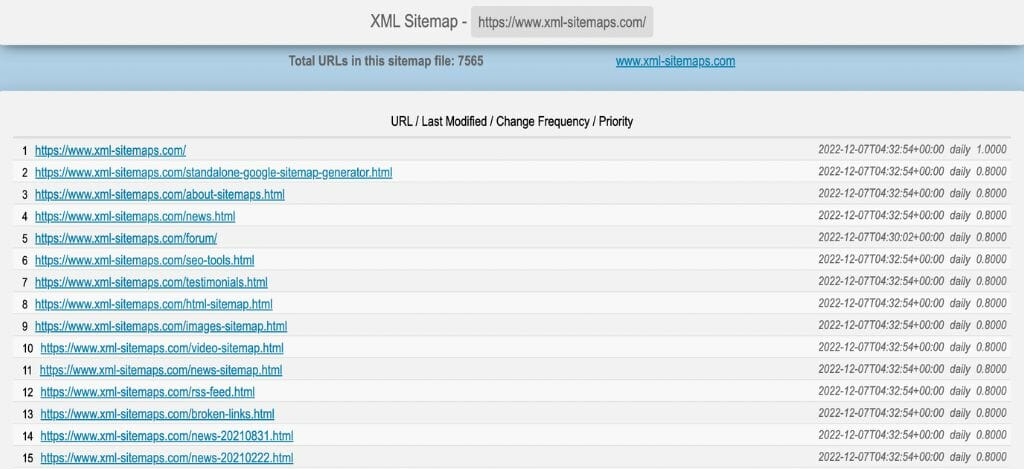
Creating a website involves more than just designing a visually appealing layout and publishing content. One of the critical components of website development is ensuring that search engines can crawl and index your pages correctly. This is where a sitemap comes in.
After years of building websites, we can help you learn why a sitemap is essential for your website and how to create one. With this information, you can optimize your website for search engines and improve its performance.
Table Of Contents
Quick Summary
A sitemap is a file containing a hierarchical list of a website’s pages and sections, designed to aid search engines and users in navigating the site’s content and structure.
It can be submitted to search engines to ensure all pages are crawled and indexed correctly, improving visibility in search results.
Sitemaps come in various formats and provide valuable organization for search engines and website visitors.
What Is A Sitemap?
A sitemap is a file that lists all the pages of a website and their relationships to each other. It helps search engines crawl and index the site more efficiently, improving its visibility and accessibility.

Sitemaps can be in various formats, such as XML or HTML. They can contain information such as the URL, last modification date, priority level, and frequency of updates for each page.
They benefit large and complex websites with a deep hierarchy or dynamic content that is not easily discoverable through traditional website navigation.
By submitting a sitemap to search engines, website owners can ensure that all their pages are crawled and indexed correctly, improving their visibility in search results.
Sitemaps can be helpful for website visitors, providing a clear and organized overview of a website’s structure and content.
Do I Need A Sitemap?
Yes, you need a sitemap for your website. A sitemap plays a vital role in helping search engines crawl and index your website efficiently, which can improve your website’s visibility and search engine rankings.

Without a sitemap, search engines may be unable to find all the pages on your website, mainly if they are not linked to other pages. This can result in some of your pages not being indexed and, therefore, not appearing in search engine results.
A sitemap can also provide important information about your website’s structure, content, and updates.
This can help search engines better understand the relevance and value of your content, improving the likelihood of your website appearing in search results.
Benefits Of Sitemaps
Sitemaps offer several benefits for websites:
Improved Crawlability – Sitemaps help search engine bots crawl your website more efficiently by providing a clear and organized structure for your website’s pages.
Better Indexing – Sitemaps make it easier for search engines to index your website’s pages by identifying the content, structure, and relationships between pages.
Enhanced Visibility – Sitemaps can improve your website’s visibility in search engine results by providing a comprehensive list of pages, including those that users or bots may not quickly discover.
Faster Indexing – Sitemaps can help speed up indexing new content on your website by providing search engines with information about changes and updates.
Easier Troubleshooting – Sitemaps can help identify issues or errors on your website, such as broken links, missing pages, or duplicate content, allowing you to fix them promptly and improve the user experience.
Types Of Sitemaps
There are two main sitemaps: XML sitemaps and HTML sitemaps.
1. XML Sitemaps
XML sitemaps are designed specifically for search engine crawlers. They contain information about the pages on your website, including their location, last modification date, and relative importance or priority.

XML sitemaps make it easier for search engine bots to crawl and index your website’s pages, improving your website’s visibility in search engine results.
2. HTML Sitemaps
HTML sitemaps are designed for human visitors and provide a navigational overview of your website. They typically include links to each page on your site, organized in a hierarchical or categorical structure. HTML sitemaps help visitors find their way around websites with a complex system.
An HTML sitemap is an actual website page, visible to visitors, with a list of clickable links to all of the pages on your site.
– Kristen McCormick, Senior Managing Editor at Wordstream.com
How To Create A Sitemap for Your Affiliate Site
Here’s a guide to help you create a sitemap:
1. Choose A Sitemap Generator
There are several online tools available that can help you generate a sitemap for your website. Some popular options include XML Sitemap Generator and Yoast SEO.

2. Configure The Settings
Once you’ve chosen a sitemap generator, you’ll need to configure the settings for your sitemap. This may include specifying the included pages, the frequency of updates, and the priority of each page.
3. Generate The Sitemap
After configuring settings, you can generate the sitemap using the generator tool. This will create a file in XML format that lists all the pages on your website and their relationships to each other.
4. Test The Sitemap
You will need to test the sitemap to ensure it functions properly. You can use online tools like Google Search Console or Bing Webmaster Tools to check the validity of your sitemap.

5. Submit The Sitemap
Once you’ve generated and tested your sitemap, you can submit it to search engines like Google and Bing. This will help them to crawl and index your website more efficiently.
How To Submit Your Sitemap To Google’s Search Console
Here’s a guide on How to Submit Your Sitemap to Google’s Search Console
Sign in to Google’s Search Console
Select your website
Open the Sitemaps report: In the left-hand menu, click “Sitemaps” under the “Index” section.
Add your sitemap: Click the “Add/Test Sitemap” button in the top right corner and enter the URL of your sitemap in the field provided.
Submit your sitemap: Click the “Submit” button to submit your sitemap to Google.
Monitor your sitemap status: After submitting it, you can monitor it in the Sitemaps report. Google will show any errors or issues it encounters while crawling your site.
Update your sitemap: If you change your website, update it and resubmit it to Google.
FAQS
Is An HTML Sitemap Good For SEO?
An HTML sitemap is good for SEO because it provides a navigational overview of your website that can help both search engines and human visitors better understand the structure and content of your site.
Can Google Read HTML Sitemaps?
Yes, Google can read HTML sitemaps. HTML sitemaps are primarily designed for human visitors but can also be crawled and indexed by search engines.
Do All Websites Have A Sitemap?
No , not all websites have a sitemap, but it is highly recommended that they do. Sitemaps are not required for a website to be crawled and indexed by search engines, but they can significantly improve the process and ensure that all pages are correctly discovered and indexed.
Who Can Create A Sitemap?
Anyone can create a sitemap for their website, regardless of their technical expertise or experience level. Many online tools and resources can help website owners create sitemaps quickly and easily without needing specialized knowledge or skills.
Create Your Sitemap Today
A sitemap is an essential component of any website’s optimization strategy. It provides a comprehensive list of all the pages on a site, allowing search engines to understand its structure and content.
By submitting a sitemap to search engines, website owners can increase their chances of being crawled and indexed effectively, improving their visibility and search engine ranking.
In today’s digital age, where websites are a crucial part of any business or organization, having a sitemap is vital to ensure that your site is easily discoverable and accessible to both search engines and users.
